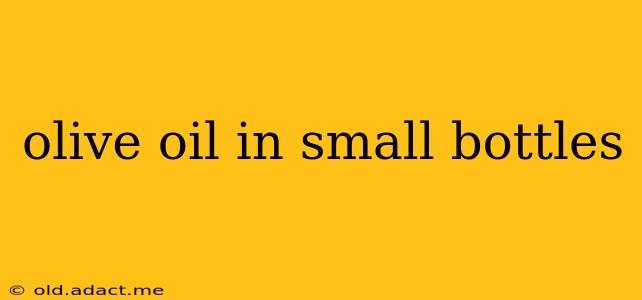Olive oil, a culinary staple prized for its flavor and health benefits, is increasingly available in convenient small bottles. This shift caters to various needs, from single-serving portions for restaurants to individual use at home. But navigating the world of small-bottle olive oil requires understanding its advantages, potential drawbacks, and best practices for selection and storage. This comprehensive guide will answer your questions and help you make informed choices.
Why Choose Olive Oil in Small Bottles?
The rise in popularity of olive oil in small bottles stems from several key advantages:
-
Portion Control: Small bottles, typically ranging from 25ml to 250ml, facilitate precise portioning, preventing waste and ensuring you use only the amount needed for each recipe. This is especially beneficial for users who may not use large quantities of olive oil regularly.
-
Freshness: Smaller bottles minimize exposure to air and light, two major factors that can degrade the quality and flavor of olive oil over time. This helps preserve the oil's delicate aroma and nutritional value.
-
Convenience: Their compact size makes small bottles ideal for travel, picnics, or packing lunches. They also take up less storage space in your kitchen compared to larger bottles.
-
Variety: Small bottles often allow for a wider exploration of different olive oil varieties and brands without the commitment of purchasing larger quantities.
What are the Disadvantages of Small Olive Oil Bottles?
While offering numerous benefits, small bottles also present some potential drawbacks:
-
Cost: The price per ounce of olive oil in smaller bottles is often higher than that of larger bottles. This is due to packaging and potentially higher manufacturing costs.
-
Sustainability: The increased use of smaller bottles can lead to a higher volume of packaging waste, although some companies are addressing this concern by using more sustainable materials.
-
Limited Selection: While the selection of olive oils in small bottles is growing, it may not be as extensive as the range available in larger bottles, especially regarding less common or specialty oils.
How to Choose the Right Small Bottle of Olive Oil
Selecting the ideal small bottle of olive oil involves considering several crucial aspects:
-
Quality: Look for extra virgin olive oil, which is the highest quality grade. Check the label for information on the olive variety, origin, and acidity level (lower is better).
-
Packaging: Choose bottles made from dark glass to protect the oil from light. Ensure the seal is intact to prevent oxidation.
-
Storage: Store your olive oil in a cool, dark, and dry place away from heat sources and direct sunlight. This will help extend its shelf life.
How Long Does Olive Oil in a Small Bottle Last?
The shelf life of olive oil in a small bottle depends on several factors, including the quality of the oil, the packaging, and the storage conditions. Generally, extra virgin olive oil stored correctly in a small dark glass bottle should maintain its optimal quality for 12-18 months from the date of bottling. However, it's crucial to always check the "best by" date on the label.
Can I Reuse Small Olive Oil Bottles?
Reusing small olive oil bottles is possible, but it's essential to thoroughly clean and sterilize them before repurposing. Ensure you remove all traces of olive oil to prevent the growth of bacteria or contamination of other products.
Are Small Olive Oil Bottles Good for Restaurants?
Small olive oil bottles are increasingly popular in restaurants, offering portion control, reducing waste, and enhancing presentation. They can elevate the dining experience, particularly when used alongside higher-quality olive oils.
Where Can I Buy Olive Oil in Small Bottles?
Olive oil in small bottles is widely available at grocery stores, specialty food shops, online retailers, and even some pharmacies. The availability may vary depending on your location and the time of year.
In conclusion, choosing olive oil in small bottles presents both advantages and disadvantages. By understanding the factors influencing quality, storage, and usage, you can select the perfect option to meet your needs, whether for personal use or professional culinary applications. Remember, prioritize quality and proper storage to maximize the enjoyment and health benefits of this versatile ingredient.
